We probably don’t need to tell you that mastering Facebook marketing is a must for any brand that hopes to succeed in 2020.
You already know that Facebook has a huge audience. A whopping 2.4 billion people use it every month.
But maybe you didn’t know how often people are using Facebook to interact with businesses of all sizes. For example, two-thirds of Facebook users say they visit a local business Facebook Page at least once a week.
Potential customers are already looking for businesses like yours on Facebook. A clear, focused Facebook marketing strategy is the only way to tap into this existing audience. As Facebook puts it, your Business Page is “a cornerstone of [your] online identity.”
Here are our best Facebook marketing tips for the year ahead.
Table of contents
Step-by-step guide to setting up Facebook for business
Types of Facebook posts
How to create a Facebook marketing strategy in 7 easy steps
Step-by-step guide to setting up Facebook for business
It doesn’t cost anything to set up a Facebook Page. Once you’ve created your Page, you can also use it to post content, link to your website, and communicate with Fans and followers for free.
That makes a Facebook Page an incredibly valuable tool for any marketer working with a limited budget.
You also need to create a Facebook Business Page before you can start using paid marketing strategies on Facebook, including Facebook ads. So, the first step of mastering how to use Facebook for business is preparing your Facebook Page.
Here’s how:
1. Create your Facebook Business Page
- Head to facebook.com/pages/create. You need to be logged into a Facebook personal account to get started, but your personal information will not appear on your new business page.
- Choose your page type: Business/brand or Community/public figure
- Enter your business details.
2. Add brand images
Upload your profile and cover photos. Make sure to use the optimum image sizes for Facebook so they look their best.
3. Complete your Page info
Click Edit Page Info and fill in the following sections:
- Description: 255 characters to describe who you are and what you do.
- Contact information: Fill in all the ways you want people to be able to reach you (including your website).
- Extra options: If it’s relevant to your business, add your operating hours, price range, and privacy policy.
4. Create your Facebook username (aka your vanity URL)
Your username helps people find you on Facebook. Click Create Page @Username to make one. It can be up to 50 characters long.
Facebook marketing ideas for your vanity URL:
- Choose a search-friendly Page name. In most cases, this will be your brand name.
- If possible, use a consistent username across social networks.
5. Add a call-to-action button
A call-to-action button gives people a quick and easy way to reach out to you, shop for your products, or otherwise engage with your business. Click Add a Button under your cover photo to set one up.
6. Review your Facebook Page settings
Your Facebook Page settings give you custom control over who sees what on your page. Take a look to make sure you understand the privacy and security settings in particular.
That’s it! Your Facebook Page is set up and ready to go.
If you’d like a little more help getting through the set-up process, we’ve got you covered. Check out our full post on how to create a Facebook Page for business.
Types of Facebook posts
Now that you’ve created your Facebook Page, you need to think about what kind of content to post.
Here’s a breakdown of the different post types you can use to engage with your followers. For inspiration, we’ve included some powerful Facebook marketing examples from successful brands.
Facebook text post (a.k.a. status post)
This is the most basic type of Facebook post. It is literally nothing but next: No photos, no videos—not even a link.
A text-only post can’t direct people to your website or drive conversions, but it can be used to spark engagement on your Page. Asking a question can be a great way to get people involved, like Kylie Jenner did in this post:
Planning on filming more YouTube videos soon. Any suggestions? ????
Posted by Kylie Jenner on Thursday, December 12, 2019
This simple question brought in more than 2,000 comments.
Even better, it brought in loads of customer feedback that Kylie can now use to craft YouTube content that she knows will resonate with fans. Asking your fans what they want can be a great way to figure out what to post.
Facebook photo post
Like a text post, a photo post is designed to build awareness or spark engagement. In general, photo posts see much higher engagement than text posts.
Photo posts are a great way to show off your products, especially if they have high visual appeal, or they’re something people need to see in use to fully appreciate.
Fresh baked cookies and glittery green nails to get into the holiday spirit ???? (????: Wonder-mint)
Posted by Color Street on Tuesday, December 24, 2019
Of course, not all businesses use Facebook to market physical products.
If you sell something less tangible, stock photos can be a great help. We’ve compiled a list of 25 free stock photo sites with some of the best images available to illustrate your posts.
You might be tempted to share images you find elsewhere online, but this can sometimes get you into trouble. Stick to our list to be safe, or make sure you fully understand the basics of image copyright.
Keep in mind that the “photo” in your post doesn’t have to be a photo at all. It could be any kind of image, like an infographic, illustration, or any other visual.
Don’t be without your yarn for the holidays! Check out our last dates for delivery
Posted by LoveCrafts Knitting on Saturday, December 7, 2019
Facebook video post
A short video post can be compelling if your product has strong visual appeal.
Since videos start to play automatically in the News Feed, even a clip that’s only a few seconds long can be a great way to catch someone’s eye. Check out this seven-second video from Orville Redenbacher’s:
With only real ingredients, you can feel good about snacking and watching… and watching… and watching… #GetReal ????
Posted by Orville Redenbacher’s on Thursday, March 28, 2019
Facebook also suggests using short videos for announcements and polls.
Longer video posts are a better bet for ongoing series or sharing memorable content. If you’re using video to tell a story, Facebook recommends taking at least one minute, and ideally three minutes or more.
The Edible History series by Buzzfeed’s Tasty is a great example:
It’s clear that video posts can be an important way to connect with followers. They see even higher engagement rates than photo posts do.
For more video Facebook marketing tips, check out our six key elements of a perfect social video.
Facebook Live video post
Facebook Live video is, not surprisingly, video broadcast live on Facebook. It can be a great way to give followers a behind-the-scenes look at your company, your product, or the personalities behind your brand.
People are into it: Since the launch of live in 2016, more than two billion people have watched a Facebook Live video.
Live is a fantastic format to share announcements in real time, or to interact with your followers directly.
For example, whether you love him or hate him, there’s no question that UK Prime Minister Boris Johnson understands the power of Facebook Live. His #PeoplesPMQs videos get hundreds of thousands of views.
People’s PMQs
WATCH LIVE: Prime Minister Boris Johnson answers your questions for #PeoplesPMQs
Posted by UK Prime Minister on Wednesday, September 11, 2019
Keep in mind that anything can happen when you go live, so be sure to prepare ahead of time by reading our complete guide to Facebook Live video.
Linked content post (aka link posts)
A linked content post is exactly what it sounds like—a post that links to content outside of Facebook.
These getter more engagement than status posts, but less than photo or video posts.
Link posts are probably the easiest kind of Facebook post to create. All you need to do is copy and paste a link into the status box. Facebook automatically populates the meta description and photo. That means you get a great-looking post with very little effort.
Make sure to add some extra text to tell readers why they should click through. Then, you’re all set.
While most of your link posts should share your own content or link to your own products, you could also share content from other thought leaders in your industry.
For example, we used a link post to share an Entrepreneur.com article about Instagram Live:
Go Live on IG to reach more people and grow your audience.
Posted by Hootsuite on Tuesday, December 17, 2019
Facebook poll post
We mentioned above that asking a question can help get your Facebook audience engaged. A Facebook poll takes this a step further
A poll offers fans the chance to vote for one of two options. Once voting is over, the results become public.
The UK domain provider 123 Reg often uses polls on its Facebook Page. Many times, the subjects are not directly related to their product offering, but they are still a good way to keep followers engaged:
Should headphones in the office be banned? Discuss…
Posted by 123 Reg on Saturday, November 30, 2019
This kind of soft-touch Facebook marketing strategy can help build brand awareness.
Facebook Stories
Facebook Stories are photo or short video posts that appear in vertical format and disappear after 24 hours. They live at the top of the News Feed. Photos appear for five seconds, and videos can be up to 20 seconds long.
More than half a billion people view Facebook Stories every day. When you’re thinking about how to use Facebook for business in 2020, Stories can offer a powerful way to connect with fans. And since Stories appear at the top of News Feed, they’re immune to the Facebook algorithm
Pinned post
A pinned post is simply a regular post that you “pin” to the top of your Facebook Page.
It’s always the first thing people see at the top of your Page.
What should you pin? Maybe you have one piece of content that soars above the rest. Something that really captures your brand and shows potential followers exactly why they should Like your Page.
You can also use this space to:
- share important news
- showcase an amazing video
- raise awareness about a current campaign
Really, you can use it for anything that will get people to engage with your brand. And you can change your pinned post as often as you like.
You can tell a post is pinned when you see a little blue thumbtack icon on the top right of the post.
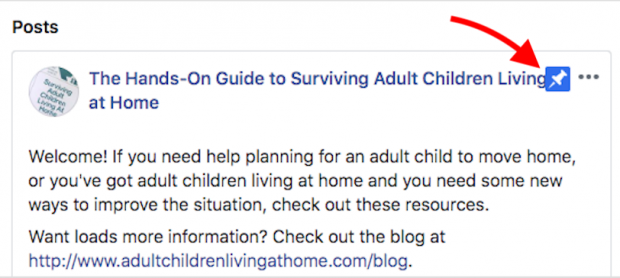
How to choose the perfect type of post
So, how can you figure out exactly what types of post to use?
One great way to learn what might resonate with your audience is to engage in social listening. This can help you learn:
- What do existing customers love about your company or your products?
- What challenges are people having that you know your product could help them address?
- How can you differentiate yourself from the competition?
You can start by posting content that’s performing well on other channels. Have you tweeted content that’s getting a great response? Share it on Facebook, too. Have a page on your blog that’s always getting new comments? That’s another Facebook post contender.
For the best results, be sure to share your content using cross-promotion best practices, rather than simply cross-posting.
Of course, if you really want to know what your audience wants to see, you can always model Kylie Jenner and ask them.
How to create a Facebook marketing strategy in 7 easy steps
Now that you understand the different kinds of Facebook posts, let’s look at some Facebook marketing ideas to help you build a solid strategy for this powerful social tool.
1. Define your audience
To engage your audience effectively, you have to first understand who your target audience is.
Ask yourself the following questions:
- How old are your target followers?
- Where do they live?
- What kind of jobs do they have?
- What are their challenges and pain points?
- How and when do they use Facebook?
To start, make sure you understand the basic Facebook demographics. Once you know who uses the platform and how that maps back to your target customer, take a look at Facebook Audience Insights.
Use Audience Insights to drill down into the nitty-gritty details about potential customers. You can use this tool to find information on things like:
- Age
- Gender
- Education
- Relationship status
- Location
- Language
- Facebook usage
- Past purchasing activity
This is one of the most important Facebook marketing tips for using the platform successfully: Always have a clear idea of exactly who you are trying to reach.
2. Set goals
It can be tempting to focus on vanity metrics, like racking up Likes. But unless those Likes are part of a broader marketing plan, they’re not going to provide a great return.
For your Facebook marketing strategy to be effective, you’ve got to have clear goals tied to real business objectives.
The goals will differ for every business, but they should all focus on actions that have a real impact on your bottom line. For example:
- generating leads
- increasing conversions on your website
- improving customer service.
These broad categories are a good place to start. Next, you need to make your goals much more specific and measurable. Here, we recommend using a recognized goal-setting framework like S.M.A.R.T. goals or the O.K.R. goal framework.
We explain both of these goal-setting systems, along with examples of how they work in practice, in our post on social media goal setting.
Everything you do on Facebook—every post, every comment, every ad—should work to support your goals. To keep things on track, it’s a good idea to distill your strategy down into a Facebook mission statement for your brand.
Having a clear picture of your goals will also help you craft an effective Facebook style guide for your brand. This will make sure you maintain a consistent brand voice that works to support the goals you choose.
3. Plan your content mix
Once you’ve set your goals, you need to create a plan for how to achieve them.
A key part of that plan is determining the right content mix. We recommend starting with either the 80-20 rule or the social media rule of thirds.
If you follow the 80-20 rule:
- use 80% of your Facebook posts to inform, educate, and entertain
- Use the other 20% to promote your brand
Remember that using Facebook for business is all about building relationships, and self-promotion is not a great way to do that. But if you provide enough value, your audience will be open to learning about your products and services in the 20 percent of posts that are more sales-focused.
The social media rule of thirds also prescribes a good mix of valuable content vs. promotional posts:
- one-third of your content should share ideas and stories
- one-third should involve personal interactions with your followers
- the remaining third can promote your business
The goal is to provide more value than promotional material to keep followers engaged.
Facebook’s algorithm will always penalize brands that push sales too hard. Facebook wants its users’ news feeds to be full of content they want to Like and share.
As a marketer, you should want that too. All those Likes and shares help extend your reach and put your brand in front of new eyeballs.
The final part of planning your content mix is to determine when and how often to post.
This will take some trial and error (using engagement data gleaned from Page Insights). But research generally shows that the best time to post on Facebook is:
- For B2B brands: between 9 a.m. and 2 p.m. EST on Tuesday, Wednesday, or Thursday.
- For B2C brands: 12 p.m. EST on Monday, Tuesday, or Wednesday
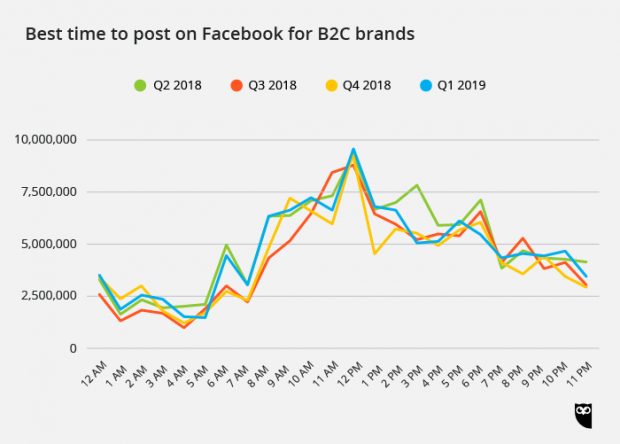
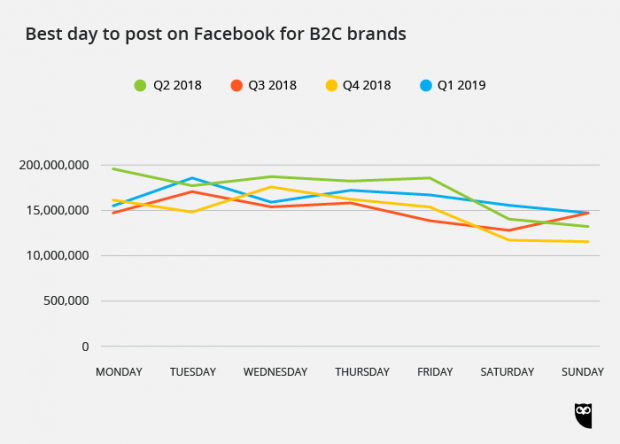
It’s important to post consistently. Create a content calendar to help balance your mix of content types and keep your posting schedule on track. We’ve created a free content calendar template you can use. The Hootsuite Planner is another great resource to help you plan and manage your Facebook content mix.
For more strategic planning ideas, check out our post on how to create a social media marketing plan.
4. Optimize your Page for engagement
In order to achieve the Facebook marketing goals you set in Step no. 2, you need to make it easy for people to find your Facebook Page. And you need to compel them to Like your Page once they get there.
Start by making sure your Facebook Business Page is fully optimized for success, as explained in this video:
Tip: Put some extra effort into your Facebook Page cover image, since it’s the first thing people will see when they visit your Page.
Next, it’s time to get those views, Likes, and Follows rolling in.
First, make it easy for people you already interact with on other channels to find your Facebook Page:
- Link to your Page in your email signature, newsletter, and other channels
- Incorporate Facebook Like and share buttons on your website and blog to make it easy for people to find, follow, and share your Page in one click
Of course, if you want people to share your content, you need to make sure the content you post to Facebook is highly shareable. Creating valuable and entertaining content that followers will be happy to share with their connections is the best way to expand your organic reach.
It bears repeating here that Facebook is a social network. If you’re not engaged with your Page, why should your followers be? Followers who find themselves talking into a void will abandon your Page for more responsive brands.
Your mantra is reply, reply, reply. Reply to every message and comment. Answer questions.
Finally, make sure your Page stays up to date. Schedule a regular audit of your Facebook Page to check for and remove any outdated content. Make sure your About section is accurate, up-to-date, and on-brand.
You can find more detailed strategies in our guide to getting more Facebook Likes and this list of little-known Facebook tips and tricks.
5. Consider using other Facebook tools
Once you’ve started to build up your following, you may want to consider adding some extra tools to your marketing plan.
Facebook Groups
With 1.4 billion people using Facebook Groups every month, it’s an audience too large to ignore. Think of Groups as the online equivalent of your favorite coffee shop or community center. They are a place for people to share information and ideas.
You can also use Facebook Groups to showcase your expertise and provide added value to your fans. This is a great way to build trust and ongoing loyalty.
For example, Shirley Weir of Menopause Chicks offers a private Facebook Group where women can talk and learn about personal topics they experience in midlife. The group is a low-commitment, high-value first point of contact that allows Shirley to develop meaningful relationships with new fans.
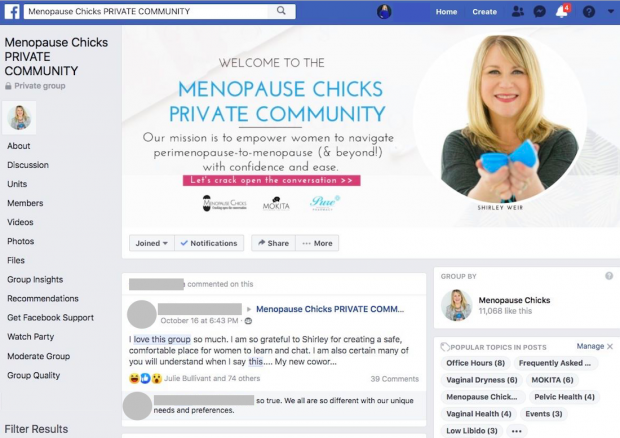
The group gained 5,000 new members in 60 days after Shirley mentioned it in a couple of media appearances. There are now more than 17,600 members, generating 35,000 questions, comments, and reactions a month—all through organic growth.
When you’re ready to add this tool to your Facebook marketing strategy, check out our step-by-step instructions on how to set up your own Facebook Group.
Sometimes fans will create their own Facebook Group with a focus on your brand (search Facebook Groups for FitBit to see this in action). It’s a good idea to join these groups to make sure that the conversation is positive and factual.
In general, though, this is a great thing. It shows your brand has a dedicated fan base that’s really into what you do!
For now, Facebook Groups are all about organic interaction, but eMarketer predicts ads will come to Groups in 2021.
Facebook chatbot (a.k.a. Facebook Messenger bot)
Facebook users exchange 20 billion messages with businesses every month. Facebook’s own research shows users expect a business to respond almost immediately. One surveyed Facebook user said he would only wait 10 minutes for a response before moving on to another brand.
Facebook suggests chatbots on Messenger may be the answer to this need for quick replies. And they cite it as a reason why the number of bots grew 5.6 times in 2018 alone.
For example, Happy Socks used a Facebook Messenger bot as a kind of personal shopper, helping people find exactly the right gifts for everyone on their Christmas list.
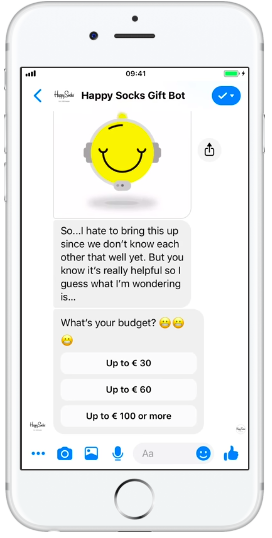
To set up your own Facebook chatbot, check out our step-by-step guide to creating a Facebook Messenger bot.
Facebook Business Manager
Once you understand the basics of your Facebook Page, it’s a good idea to set up Facebook Business Manager. Facebook calls it “a one-stop shop to manage business tools, business assets and employee access to these assets.”
It’s a tool that allows you to manage your organic and paid Facebook posts. It also allows you to work effectively with team members and outside contractors and agencies.
We walk you through the set-up process in our step-by-step guide to using Facebook Business Manager.
6. Incorporate Facebook ads and the Facebook pixel
Just because you post something on your Facebook Page, that doesn’t mean all your followers will see it. In fact, you might be surprised by the percentage of followers your organic posts will likely reach:
- For Pages with fewer than 10,000 followers: 8.18% organic reach
- For Pages with more than 10,000 followers: 2.59% organic reach
This is because the Facebook algorithm prioritizes posts from users’ friends and family.
Fortunately, you can extend your reach without breaking the bank using Facebook Ads.
Like any advertisement, a Facebook ad is content you pay to share with a specific, targeted audience. It’s all about getting your brand in front of the right eyeballs and achieving your conversion goals.
Facebook has advertising options designed for business goals both on and off the network—from brand awareness and engagement to app installs and store visits. This video provides an overview of how to set up a Facebook ad campaign.
For more on how to launch a targeted Facebook ad campaign, check out our complete guide to advertising on Facebook.
An important note here: Even if you don’t plan to use Facebook ads right away, it’s a good idea to set yourself up with a Facebook pixel now.
A Facebook pixel is a simple piece of code that you place on your website to:
- track conversions
- remarket to people who have already visited your website
- build targeted custom audiences for future ads
The pixel will start collecting data as soon as you place it on your site, so you’ll have remarketing and custom audience information ready when you start your first campaign.
7. Track, measure, and refine
Facebook marketing is not a set-it-and-forget-it strategy. You’ve got to track and measure performance so you can see what worked and what didn’t. This will reveal how you can improve your strategy in the future.
Facebook offers built-in audience engagement tracking through Facebook Insights. You can measure:
- likes
- reach (how many people saw your posts)
- engagement (how many people liked, clicked, shared, or commented)
- which of your posts result in people unliking your Page
Facebook Insights will also help you determine which post types work best for your Page, so you’ll know if your current content mix is working. We’ve got all the details in our beginner’s guide to Facebook Analytics.
For actions outside of Facebook (like purchases or other website conversions), you need to use tools like Google Analytics, Hootsuite Impact, UTM parameters, and Hootsuite Insights.
We’ve created a detailed guide that walks you through the process of tracking the return on investment of your Facebook marketing.
Beyond tracking your success, it’s important to use the information about what’s working and what’s not to make adjustments to your Facebook marketing strategy. The data will show you what you should keep doing, and which tactics you need to tweak.
Through a continuous loop of goal-setting, measuring results, and tweaking your strategy, you can improve your performance over time.
There’s a lot to learn when it comes to Facebook marketing, and it might all seem a little overwhelming at first. The good news is you can get started without investing a dime. Then, branch out into more complex strategies and paid campaigns as you gain expertise.
Manage your Facebook presence alongside your other social media channels using Hootsuite. From a single dashboard you can schedule posts, share video, engage your audience, and measure the impact of your efforts. Try it free today.
Get Started
